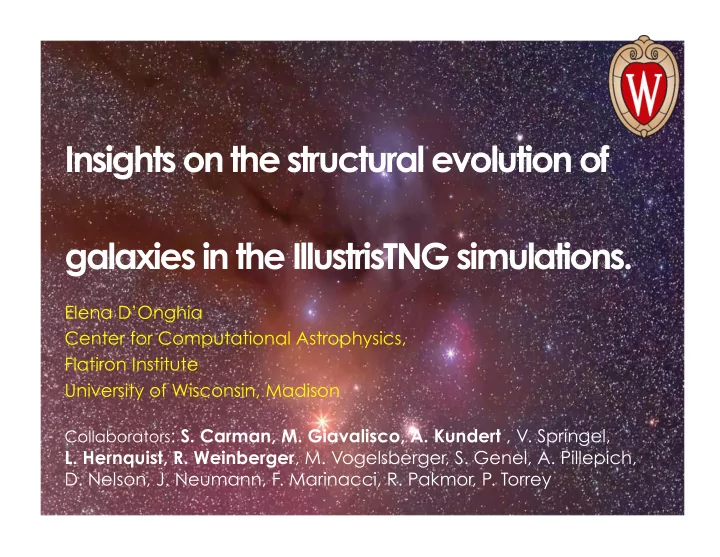

Insights on the structural evolution of galaxies in the IllustrisTNG simulations. Elena D’Onghia Center for Computational Astrophysics, Flatiron Institute University of Wisconsin, Madison Collaborators : S. Carman, M. Giavalisco, A. Kundert , V. Springel, L. Hernquist, R. Weinberger , M. Vogelsberger, S. Genel, A. Pillepich, D. Nelson, J. Neumann, F. Marinacci, R. Pakmor, P. Torrey
Questions � What did the observation show? 1) At a given stellar mass high redshift galaxies have higher SF than lower z 2) The Central density (1 kpc) correlates with sSFR 3) Quenched galaxies have about constant central density ? What do simulations show? We use the IllustrisTNG simulations for galaxies with M>10^9 up and follow them fom z=1 to z=4
Simulations show that galaxies are: star forming, in the green valley and quenched!
Core density vs. sSFR Green valley SFGs show a big variety of core density at all redshift. Quenched galaxies show roughly constant core density Quick variation in the core density tells that quenching is fast as galaxies leave the main sequence they quench
General Properties are reproduced SFG Quenched All Core density scales with the stellar mass- � more massive galaxies higher core density
Core-density relation at z=1 Resolution of illustris is sufficient to reproduce scaling relations (SCALING RELATIONS ARE IN AGREEMENT WITH Feng et al. 2013)
The evolution of the Gini parameter The Gini parameter of the dark matter increases as z decreases! Dark matter follows the baryons, possibly due to the adiabatic contraction!
More on the mass distribution as a function of time Similar trends even when galaxies are divided by quenched and star forming
What are we learning? 1) The baryons dissipates quickly with a timescale faster than the relaxation timescale of dm - � dm follows baryons in the center 2) However the mass distribution evolves in a way that the denser parts become denser, and globally the density increases within 3-8 kpc 3) How this relates to the Genzel’s large baryonic fraction?
Genzel et al. 2017: At redshift 1<z<2.5 the rotation curves of massive disks turn downward over the same scales where, in the local universe, they remain flat strongly baryon dominated HOW DO GALAXIES evolve from being so baryonic dominated to be dm dominated?
Open questions that can be answered by simulations: 1) Why dm gini increases when decreases? Adiabatic contraction role and accretion? 2) Quenching must be a rapid process, how does it happen? Relation to the variation of the gini parameter. 3) How is the dm Gini parameter at z=0? If it increases then this reflects the relaxation time of the dm
Recommend
More recommend